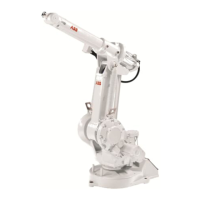4 Repair
4.1.4 Fitting new Bearings and Seals
3HAC026320-001 Revision: A 69
Seals
The most common cause of leakage is incorrect mounting.
Rotating Seals
Flange Seals and Static Seals
Action
1. The seal surfaces must be protected during transportation and assembly
2. The seals must either be kept in their original packages or be protected well.
3. The seal surfaces must be inspected before mounting. If the seal is scratched
or damaged in such a way that it may cause leakage in the future, it must be
replaced.
4. The seal must also be checked before it is fitted to ensure that:
1. The seal edge is not damaged (feel the edge with your finger nail),
2. The correct type of seal is used (has a cut-off edge),
3. There is no other damage.
5. Seals and gears must be fitted on clean workbenches.
6. Grease the seal just before it is fitted – not too early as otherwise dirt and
foreign particles may stick to the seal. The space between the dust tongue
and sealing lip should 2/3-filled with grease of type Shell Alvania WR2 (ABB’s
art. No. 3537-1).
1. The rubber coated external diameter must also be greased.
7. Fit the seal correctly. If it is fitted incorrectly, it may start to leak when pumping
starts.
8. Always use an assembling tool to fit the seal. Never hammer directly on the
seal because this will cause it to leak.
9. Use a protective sleeve on the sealing edge during assembly, when sliding
over threads, key-ways, etc.
Action
1.
Check the flange surfaces. The surface must be even and have no pores. The even-
ness can be easily checked using a gauge on the fitted joint (without sealing com-
pound).
2.
The surfaces must be even and free from burr dust (caused by incorrect machining).
If the flange surfaces are defective, they must not be used as they will cause leakage.
3.
The surfaces must be cleaned properly in the manner recommended by ABB.
4.
Distribute the sealing compound evenly over the surface, preferably using a brush.
5.
Tighten the screws evenly around the flange joint.
6.
Make sure that the joint is not subjected to loading until the sealing compound has
attained the hardness specified in the materials specification.

